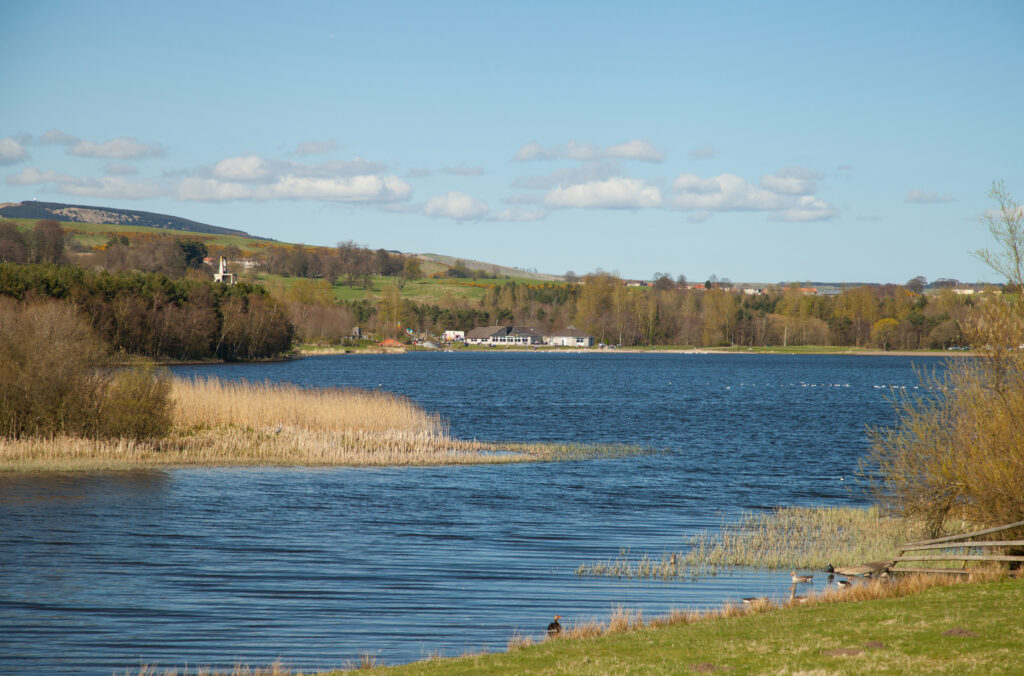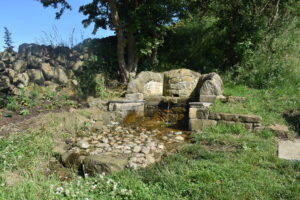Lochore Meadows to Kinglassie
Lochore Meadows to Kinglassie – Route Information
Lochore Meadows Country Park with its loch and wildlife offers the perfect place to rest weary legs while enjoying fine scenery and hospitality. As you follow the Fife Pilgrim Way out of the park, you pass the ruins of Lochore Castle, once one of the strongest castles in the area. There are a number of waymarked walks around Lochore Meadows, including the Sleeping Giant Path which takes walkers over Benarty Hill to RSPB Loch Leven.
Look out for the Fife Pilgrim Way waymarker as you leave Lochore Meadows as it’s easy to miss the route. The path then winds slightly uphill into pasture land rich with wild flowers and shrubs. Pause to appreciate the views. There is a fine viewpoint at Harelaw Cairn if you’re prepared to divert a short way.
The road to Kinglassie can be busy with traffic, but there is a pavement all the way. Walkers can visit sites that were visited by medieval pilgrims: Kinglassie Parish Church and St Finglassin’s Well. On leaving Kinglassie, the route climbs over the hill above the village where the views are lovely, before it follows the River Leven and descends on a pretty countryside trail into Leslie. The next section of the route is the Kinglassie to Markinch section, which takes in Glenrothes – designated a new town in 1948 – and Markinch with its ancient church and Stob Cross. Markinch has good bus links and a mainline railway station.
Uncover more unmissable sights at The Story of Fife Pilgrim Kingdom.
Lochore Meadows
In this area of Fife, the paths taken by pilgrims hundreds of years ago are now largely concealed beneath the industrial landscape. The medieval travellers looked out for each other when the going got tough, and were bonded through shared experience. In this way, they were not so dissimilar to the mining communities that later developed here.
To find out more about the facilities and activities available visit Lochore Meadows Country Park.

Kinglassie – Deadly devotion
Kinglassie was a popular rest point for pilgrims making their way to St Andrews. There has been a church here since the 1100s, although the current one dates from 1773. The parish church and St Finglassin’s holy well were popular pilgrim destinations as places for healing and prayer.
Following the Protestant Reformation in the late-1500s, pilgrimage was outlawed in Scotland. A Parliamentary Act of 1581 made pilgrimage to chapels, wells and crosses a punishable offence. The Synod of Fife felt the need to pass a further motion in 1649 demanding punishment for visiting holy wells. But people were clearly prepared to take the risk.
It is unknown whether the name of the village, its church and well come from the Gaelic Kil Glaisne, meaning ‘church by the burn’, or whether they are named after an actual saint.
Visit the resources section of our website for further information on the Fife Pilgrim Way. You can purchase the Fife Pilgrim Way map and Guide Book in our online shop.
A new Fife Pilgrim Way Passport has been created, which allows walkers to have their passport stamped as they follow the route across fife. Passports can be stamped at the following locations. Before you set off please visit our Stay Safe in the Countryside page for things to consider when you are in the outdoors.
Simon Hessett recent became the Fife Pilgrim Pastor you can visit his webpage here.
